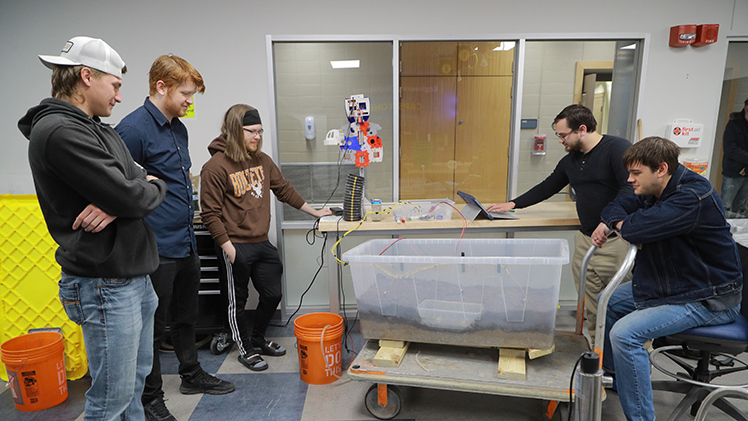Tile drainage systems installed under rows of agricultural crops don’t just carry away excess subsurface water. These systems also carry away nutrients, especially when a sudden rain prevents fertilizer from properly saturating the soil.
That’s a problem for farmers, whose crops and finances stand to suffer.

The Senior Design Expo will be combined for the first time this semester with a new Day of Research, highlighting additional student and faculty research activities in the college.
It’s also a problem for wider communities affected by harmful algal blooms that are fed by common agricultural nutrients like phosphorus and nitrogen.
“If it rains within 24 hours of when you spray fertilizer, those chemical run straight off. They leach into the watershed,” said Ethan Altman, a mechanical engineering technology senior who can speak from experience having grown up on his family’s farm near Holgate, Ohio. “That’s a major problem, especially in northwest Ohio with the harmful algal blooms on western Lake Erie. So we’re hoping we can fix it.”
Altman is part of a team of five mechanical engineering technology seniors who share that goal ahead of the College of Engineering’s Senior Design Expo on Friday, April 26. Their working model of a multipart system designed to better manage agricultural drainage and irrigation will be one of more than 25 self-guided projects on display. Each showcases students’ creativity and ingenuity while tackling a real-world challenge, in some cases in collaboration with local businesses, industries and federal agencies.
A long-standing tradition and a requirement for graduation in the College of Engineering, the Senior Design Expo will be combined for the first time this semester with a new Day of Research, highlighting additional student and faculty research activities in the college.
“The College of Engineering is a leader on campus in research and scholarly activities,” said Dr. Patricia Relue, senior associate dean of research and graduate studies in the College of Engineering and a professor in the Department of Bioengineering. “During the event on Friday, April 26, our team will unveil several new research initiatives to enhance the position of our college in leading large-scale research projects.”
The Senior Design Expo is from noon to 3 p.m. on the first floor of Nitschke Hall. The Day of Research runs concurrently with student research poster presentations from noon to 3 p.m. on the first floor of Nitschke Hall, tours of labs from 1:30 to 2:30 p.m. in the newly renovated North Engineering Building and rapid faculty research presentations followed by a networking reception from 3 to 4 p.m. in North Engineering 2108.
Visitor parking is free between 11:30 a.m. and 5 p.m. in Area 20. For more information on the event, go to the College of Engineering website.
Altman’s insights into tile drainage informed his senior design project with Thomas Codispoti, Robbie Nicely, Luke Reese and Jacob Stokes. Tile drainage is a technique to remove subsurface water from fields dating back to the ancient Romans. Its name reflects the ceramic tiles that once made up these systems of underground tunnels, although plastic tubing is a more commonly used material today.
The student team developed a system that collects the water that’s removed from the fields via tile drainage in a pond or reservoir, where it waits until moisture sensors placed in the fields indicate crops are getting thirsty. This triggers an automated pump to push the nutrient-rich water back into the field through the same system of “tile” tubing.
Another element of their design addresses the occasional but inevitable situation where heavy rains overflow the reservoir. They propose a filter to capture nitrates and phosphates before the water enters the watershed.
Senior Design Expo guests will see a small-scale working model of their system, with a dirt-filled container representing the field and a bucket representing the reservoir.
Altman, Codispoti, Nicely, Reese and Stokes credit the semester-long experience of building their model as a positive learning opportunity. In working on the automated relationship between the moisture sensor and the pump, for example, Nicely advanced his command of the programming language C++. The whole team worked through trial and error to determine the size of the pump needed for their model.
Stokes described another challenge.
“As engineers our main goal is to problem solve, and one of our problems we had to solve was the budget,” he said. “We had to develop unique ideas, like 3D-printing the fittings on our tile system. The fittings are basically identical to the ones you can buy in a store but making them ourselves helped us reduce the cost.”
Other examples of projects to be on display at the Senior Design Expo include a continuous positive airway pressure (CPAP) machine to specifically accommodate patients in intensive care units, a billboard to enable advertisers to target passers-by through object-recognition technology and a design for a pedestrian bridge across the Ottawa River in the village of Ottawa Hills.
“The senior design project is a key example of experiential learning in the College of Engineering,” said Dr. Mohammad Elahinia, interim dean of the College of Engineering and a University Distinguished Professor in the Department of Mechanical, Industrial and Manufacturing Engineering. “Students also get practical experience from project-based learning, mandatory co-ops and graduate research opportunities.”
The irrigation system team said they see real-world potential for their model.
“I’ve talked to farmers back home about it, and they think they could use it,” Altman said. “So hopefully, one day, we’ll have a company and see this model at full scale.”